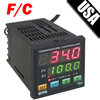Just for kicks:
Annealing case necks by dipping them into molten lead that is held at about seven hundred degrees ‘F’ works well. Wheel weight alloy, which is approximately eighty nine parts lead, one part tin and ten parts antimony, melts at six hundred and nineteen degrees ‘F’ so you can safely set your lead alloy temperature at seven hundred degrees ‘F’. The use of a thermometer will take any guesswork out of the process. The reason for using lead for annealing is to keep the temperature low enough for proper uniform annealing, and that is simply not possible using the torch method. With a torch the case is often heated on one side more than the other, temperatures are not readily repeatable from case to case, and in falling over into the water, one side is quenched before the other.
To minimize the likelihood of lead ‘soldering’ itself to the brass case it is best to use as close to pure lead as possible (although any lead alloy will work). Anneal your cases with the fired primers left in, as that forms an airlock that keeps lead away from the inside of the case. With respect to annealing cases using molten lead, basically you: set the thermostat on your pot at seven hundred to eight hundred degrees ‘F’ pick up each case by the head and dip the neck of the cases about a quarter-inch into some powdered graphite or light oil (vegetable oil is fine). The oil keeps lead from sticking to the brass but, any lead that does stick is easily removed by a quick twist in steel wool while the case is still hot. Shake off any excess oil, dip the neck, shoulder, and about a quarter-inch of the case body into the molten lead and just as you begin to feel an uncomfortable degree of heat in your fingertips, drop the case into water. If you hold the cases in some other way than with your bare fingers, leave them in the molten lead from eight to twelve, but not more than fifteen seconds. When the case is hot enough that the lead does not cling to it, it is annealed. Pull the case up out of the lead, tap on the side of the case to remove any bits of lead (if the lead is really sticking, the case isn't annealed!), then drop it mouth down (straight) into a container that is mostly full of ice water. Following the anneal, it would be wise to closely inspect the inside of the case both visually and with a bent paper clip just to make sure there are no lead drippings adhering to the inside the case.
If you are left-handed, have the cases on the right side, the lead in the middle, and the ice water on the left. The cases go only one direction, to the left, and you use only one hand. If you are right handed, reverse the set-up. Because it only takes a few seconds per case, you can anneal hundreds of cases in an hour with this method. After the annealing process, remove the cases from the water, shake them out and use a piece of bronze wool to clean the annealed portion. This removes any residual lead and/or burned oil. Then, dry and tumble the cases to remove any traces of residual oil and they are ready to process.




